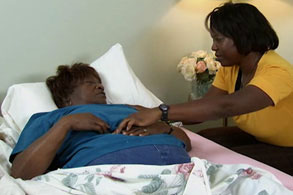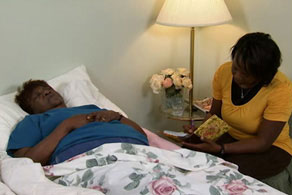What to Do

The biggest challenge you will face is knowing when a person has pain and then deciding what to do. Your ability to help the person you care for depends on recognizing pain.
Common Signs of Pain
Pain usually affects how a person speaks, looks, moves, and acts around others. When you see the signs of pain, ask the person if he or she is in pain. Signs of pain include:
- Moaning, crying, gasping, or grunting.
- Shallow breathing or short breaths.
- Grimacing, clenching teeth, biting lips, tightly closing or widely opening the eyes and mouth.
- Restless movement, muscle tension, increased hand and finger movements, pacing, holding or rubbing a body part, or being unwilling to move.
- Not wanting to talk, a reduced attention span, note wanting to be around others, loss of appetite.
- Trouble sleeping (either difficulty falling asleep or waking up early.)
Signs of Pain in Persons who do Not Speak
Persons with dementia, severe stroke, mental retardation, or psychosis are often not able to report their pain. Being able to recognize pain means you must know the person well. Changes in behavior and body movements are the signs of pain, including:
- Grimacing, clenching teeth, biting lips, tightly closing or widely opening the eyes and mouth.
- Shallow breathing or short breaths.
- Restless movement, muscle tension, increased hand and finger movements, pacing, holding or rubbing a body part, or being unwilling to move.
- Trouble sleeping
- Aggressive behavior
Learn as Much as You Can

If a person develops pain, you want to learn as much as you can so that you can inform their doctor. This is very important with acute or chronic pain that suddenly changes in character. Many people, especially those with a heart problem may not say they have pain, but will use words like “pressure”.
When a person is in pain, ask them these questions:
- On a scale of 0 to 10 with 0 being no pain and 10 being the worst pain you ever had, tell me what your pain feels like now.
- It helps to know a person’s personal pain scale. Ask them “What is the lowest level of pain you have had? What is the highest level of pain you have had?” Knowing this will help you decide how well their pain medicine is working and whether or not you need to call their doctor.
- Ask the person to “Show me where your pain is”. (Have the person point to the area). Then clarify, for example, “Do you mean your stomach or your chest? Your arm or wrist?”
- Ask the person how long he or she has felt the pain. When did it start?
- Ask the person to describe the pain. Do not describe it for them. “Tell me what the pain feels like. Is it dull, sharp or achy?”.
- Ask the person to describe anything that makes the pain worse, such as lying down, sitting, or chewing.
- Ask the person if there is anything that lessens the pain, such as lying down, taking an analgesic, eating food.
- Watch how the person acts or behaves (for example, bends over, holds a body part, bends the knees up towards the chest while lying down).
Keep a record in your care diary and write down all of the information so that you can report it to the person’s doctor.
How to Act
The nature of a person’s pain will determine what you should do. Always remember that if you have any doubt at all about a person’s pain and the person’s condition, call their doctor or emergency medical services (EMS).
- If a person develops sudden, acute pain, is in distress, and has not had the same type of pain in the past, call 911. Learn as much as you can about the person’s pain so you can answer questions when EMS arrives. When a person is in severe pain, he or she might not be able to answer questions. Observe as much as you can about how the person acts and moves.
Do not transport the person in your car. If the pain is serious, as in the case of a heart attack, the person will be treated in the ambulance. You cannot give treatment in your car and the person might become worse as you drive to the hospital. People don’t always feel the need to call 911. Listen to your instincts. You could risk their life by not calling emergency services. - If a person has acute pain, the same as pain in the past, e.g. back pain, pain from a muscle sprain or tear, pain from surgery, first see if it is time to take any pain medicine ordered by their doctor. If so, give the medicine. Provide a quiet environment. Then, keep an eye on the person after giving the medicine and if there is no relief within 30 minutes call their doctor.
The doctor will order the specific times when it is safe to give pain medicine.
Pain medicine taken regularly around the clock (ATC) is best because it keeps medicine at the same level in the body at all times. Sometimes pain is not constant and does not occur regularly. In this case, the doctor may order medicine “as needed” or PRN. For example, the doctor may order the pain medicine to be given “every 4 hours as needed for pain”. You should not give the medicine any sooner than every 4 hours. But, you may not need to give it every 4 hours, depending on the pain level of the person you are caring for. Remember to give pain medicine to the person you care for at the right time.
Adjusting the Environment

Whether a person has acute or chronic pain, there are things you can do in addition to giving them their pain medicine that will help in lessening their pain. These include:
- Give the pain medicine at the right time so the pain can be controlled.
- Ask the person what you can do to help him or her relax
- Help the person position in bed, Making him or her as comfortable as possible. See our future lesson on positioning.
- Darken the bedroom and remove any noises.
- Remove or loosen any tight fitting clothing.
- If the person likes music, turn on a song the person finds soothing or relaxing. Have the person tell you how loud to set the sound.
- Sometimes distraction takes a person’s mind off the pain. See if they want to talk, read a story from the newspaper or magazine, watch television or meditate.
- Offer to just sit with them, perhaps join in prayer.
- Help coach the person through relaxation exercises (See our future lesson on relaxation exercises).
- When a person has chronic pain they usually have found activities that lessen their pain. Assist them with these activities (i.e. soaking in a warm bath, massage to the area, etc)